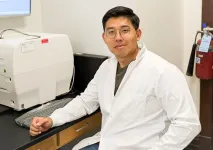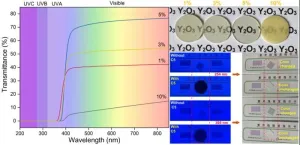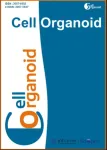(Press-News.org) URBANA, Ill. — Nanozymes are tiny, engineered substances that mimic the catalytic properties of natural enzymes, and they serve a variety of purposes in biomedicine, chemical engineering, and environmental applications. They are typically made from inorganic materials, including metal-based elements, which makes them unsuitable for many purposes due to their toxicity and high production costs.
Organic-based nanozymes partially overcome some of these problems and have the potential for a broader range of applications, including food and agriculture, but they are still in the early stages of development. A new paper from the University of Illinois Urbana-Champaign provides an overview of the current state of organic nanozymes and their future potential.
“Inorganic nanozymes have only been around since 2007, when researchers discovered that iron oxide nanoparticles could perform catalytic activity similar to natural enzymes like peroxidase. Their usage has rapidly advanced, but they have some major drawbacks. They are made from expensive ingredients, and they require a time-consuming, heavy engineering process for fabrication. They are potentially toxic to humans and the environment, and they aren’t naturally degradable so they cause waste management issues,” said lead author Dong Hoon Lee, a doctoral student in the Department of Agricultural and Biological Engineering (ABE), part of the College of Agricultural, Consumer and Environmental Sciences and The Grainger College of Engineering at the U. of I.
These issues led to the emergence of organic nanozymes a few years ago, said Mohammed Kamruzzaman, assistant professor in ABE and co-author of the study.
“Organic nanozymes are cost-effective, non-toxic, and environmentally friendly. The fabrication process is less complicated, and they can be produced in a few hours, compared to several days for inorganic nanozymes,” he stated.
“They are also much less expensive. The precious metals that are used for inorganic nanozymes cost around $400 per gram, while the organic materials and transition metal components cost less than 50 cents per gram. This makes them much more accessible for use in real-world applications outside of the laboratory,” he added.
Furthermore, organic nanozymes are sustainable, and some of them are biodegradable. They still contain a small metal component, such as iron or copper, which is needed to form an ‘active site’ for the enzyme-like catalytic activity, but at a much lower toxicity level.
In the paper, the researchers identify four main types of organic nanozymes based on the organic materials that are used in creating them, including polymers, biomacromolecules (primarily cellulose), organic compounds, and biological materials such as DNA and peptides. They outline chemical structure, components, functionality, and catalytic activity for each of these types, providing fundamental information for other scientists. They also illustrate the corresponding applications from agriculture, food, and environment to biomedicine.
Inorganic nanozymes originated in the biomedical area, and that’s where approximately 80% of research occurs, Kamruzzaman noted. For example, they are used in diagnostic medicine, imaging, therapeutics, and biosensing. However, there are concerns about innate toxicity and their impact on cell viability in therapeutic applications. Organic nanozymes can alleviate those concerns and extend applications to food and agriculture.
In a previous study, Kamruzzaman and Lee pioneered the use of agricultural-centered organic nanozymes and incorporated molecular sensing tools that can detect the presence of agricultural pesticides in food products. The ultimate goal is to create a simple test kit that people can apply anywhere and scan the results with a phone app to get a color reading that indicates the concentration of pesticide in the food. Several additional organic nanozymes made from sustainable materials have also been introduced, and further advanced molecule sensing systems are underway.
“Organic nanozymes have many advantages compared to inorganic nanozymes, but they are still in the early development stages, and there are many challenges that we need to overcome to apply them in the food and agriculture sector,” Kamruzzaman said.
One obstacle is a limited range of suitable organic materials for production. The researchers note that lipids or amino acids are promising materials for future prototypes that could play a crucial role in developing the next generation of nanozymes.
The paper , “Advancements in organic materials-based nanozymes for broader applications,” is published in Trends in Chemistry [DOI: 10.1016/j.trechm.2024.06.007].
END
Organic nanozymes have broad applications from food and agriculture to biomedicine
2024-07-30
ELSE PRESS RELEASES FROM THIS DATE:
Ce-doped yttria transparent ceramic: A new ultraviolet-shielding material for extreme conditions
2024-07-30
Ultraviolet (UV) radiation can break most of the chemical bonds in organic matter, and prolonged exposure to ultraviolet light can cause significant harm to humans and objects. In response, UV-shielding materials have been developed to fulfill various commercial requirements, including UV-shielding windows, food containers, contact lenses, and masks. While existing UV shielding materials are suitable for daily use, their effectiveness diminishes in high-temperature, high-pressure, corrosive, and radioactive environments. Organics fail at high temperatures, and films or coatings tend to flake under harsh conditions; glass is constrained ...
New journal Cell Organoid launched to propel advancements in organoid technology
2024-07-30
Organoid technology began with Professor Hans Clevers' 2009 breakthrough in cultivating the first intestinal organoid from mice. Since then, the field has expanded exponentially, showcasing organoids' remarkable capabilities in replicating human organ physiology and pathology. Organoids, which are three-dimensional stem cell cultures, offer powerful tools for studying organ development, modeling diseases, and facilitating drug discovery. Their ability to maintain genetic diversity and mimic complex biological processes makes them invaluable in biomedical ...
Endocrine Society merges with program director organization APDEM
2024-07-30
WASHINGTON—The Endocrine Society, the world’s oldest and largest organization of scientists devoted to hormone research and physicians who care for people with hormone-related conditions, announced it is merging with the Association of Program Directors in Endocrinology, Diabetes and Metabolism (APDEM).
APDEM represents the academic leaders of more than 135 training programs that prepare fellows for clinical and research careers in endocrinology and metabolism.
“The Endocrine Society and APDEM share a commitment to ...
JMIR Publications launches new peer-reviewed journal: JMIR XR and spatial computing
2024-07-30
(Toronto, July 30, 2024) JMIR Publications, a leading publisher in digital health research, announces the launch of JMIR XR and Spatial Computing, a cutting-edge journal dedicated to exploring the transformative potential of extended reality (XR) and spatial computing technologies in clinical practice.
This new journal arrives at a pivotal moment when recent advancements in artificial intelligence (AI), graphical processing, display technology, and network connectivity are propelling XR and spatial ...
(Epi)genetic aspects of metabolic syndrome pathogenesis in relation to brain-derived neurotrophic factor expression
2024-07-30
Metabolic syndrome (MetS) is a multifaceted disorder that impacts approximately 20–25% of the global population. This syndrome encompasses a range of conditions, including obesity, type 2 diabetes mellitus, hyperinsulinemia, insulin resistance (IR), hypercholesterolemia, nonalcoholic fatty liver disease, nonalcoholic steatohepatitis, and systemic metabolic inflammation. These conditions collectively lead to severe diseases and increased premature mortality. The hypothalamus, a critical brain structure regulating ...
Controlled Release Society inducts SwRI’s Dr. James Oxley into College of Fellows
2024-07-30
SAN ANTONIO — July 30, 2024 — Dr. James Oxley, an Institute scientist at Southwest Research Institute’s Chemistry and Chemical Engineering Division, has been named a Fellow by the Controlled Release Society. Recognized for excellence and innovation in delivery science, Oxley is an expert in microencapsulation, nanoencapsulation and other controlled-release technologies used in energy, food, pharmaceutical, cosmetic and consumer product applications.
“I’m honored and humbled by this recognition,” said Oxley, who began his Institute career in 2004. “Encapsulation research ...
Arthritis drugs may relieve long COVID lung symptoms
2024-07-30
University of Virginia School of Medicine researchers have identified a potential treatment for the respiratory symptoms of long COVID after discovering an unknown cause of the condition inside the lungs.
The UVA researchers, led by Jie Sun, PhD, found that COVID-19 infection can cause sweeping changes in immune cells inside the lung tissues, promoting scarring and driving ongoing inflammation even after the initial infection has passed. This ongoing inflammation, they believe, drives the lasting respiratory symptoms, such as cough and difficulty breathing, associated with long COVID.
The new research from Sun and ...
New type of “antibiotic” generated from the long pepper recommended
2024-07-30
BEER-SHEVA, Israel, July 30, 2024 – Antibiotic resistant bacterial pathogens are on the rise, while fewer antibiotics are being developed. Prof. Ariel Kushmaro and his local and international colleagues tackled the need by focusing on the long pepper. Known in traditional medicine for its treatment of a variety of illnesses, the team created a derivative that disrupts bacterial chemical communication.
Their findings were just published in Biofilm (https://doi.org/10.1016/j.bioflm.2024.100215).
Many plants' secondary metabolites are essential ...
ACE-ing protein detection in single cells
2024-07-30
By Benjamin Boettner
(BOSTON) — Since the 1950s, researchers have used a famous method invented by Wallace Coulter known as “flow cytometry” to characterize different types of immune cells in research studies and in blood samples from human individuals. This has enabled a much deeper understanding of immune cell development as well as new ways to assess human health and diagnose various blood cancers. Later, flow cytometry was applied also to other cell types.
In traditional flow cytometry, cell surface and intracellular proteins are detected with antibody molecules that are linked to fluorescent probes. However, while providing single-cell ...
Study finds police misconduct ‘hotspots’ across Florida
2024-07-30
Not all police misconduct is the same. Misconduct can range from offenses like homicide and sexual assault to seemingly minor infractions such as accepting free coffee from the public. Exactly what qualifies as police misconduct varies locally, and the response to this behavior is typically handled internally by law enforcement.
The absence of a commonly accepted framework to assess and interpret police misconduct remains a complex and contentious issue. Moreover, progress in researching this area is hindered by the limited ...








